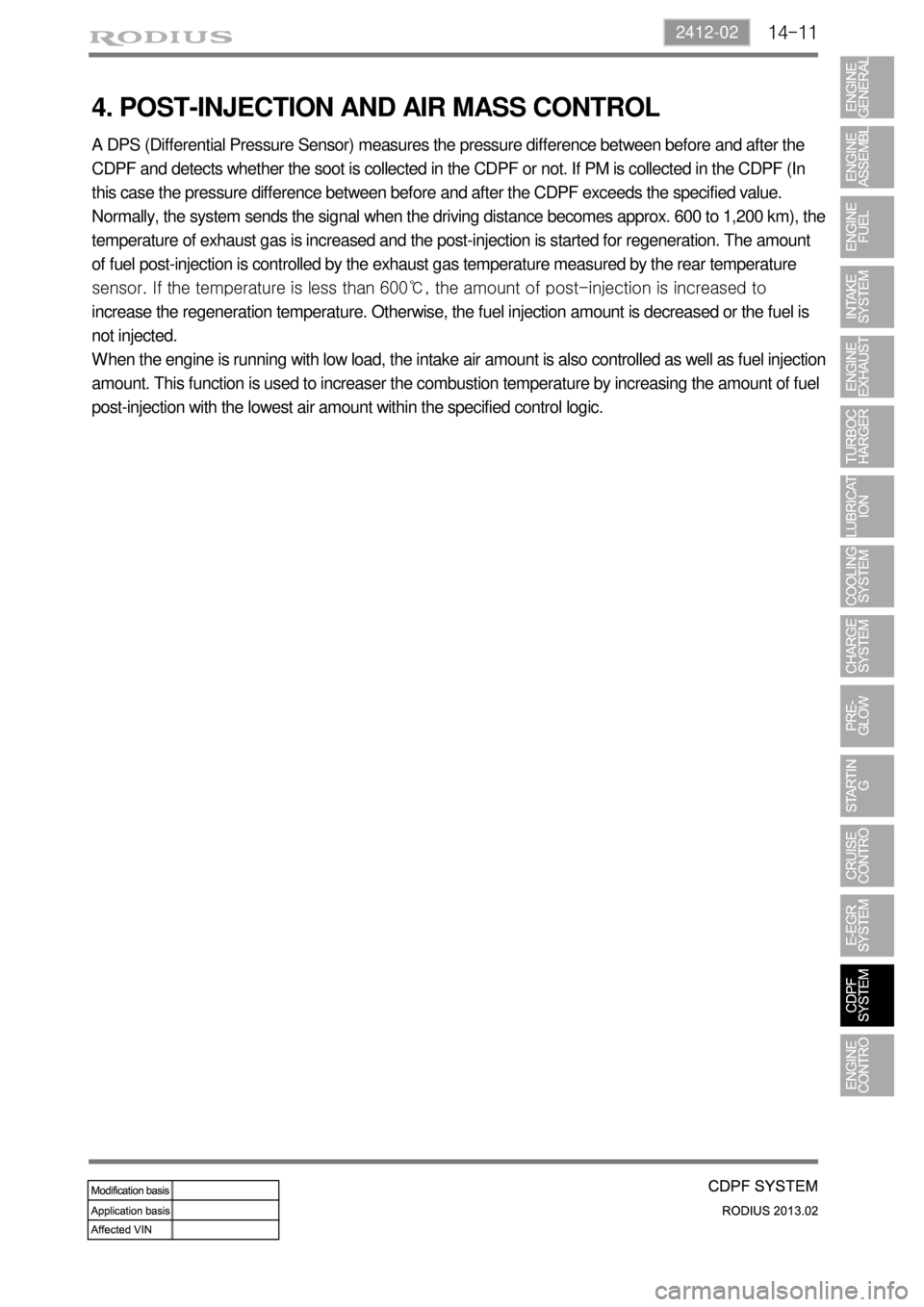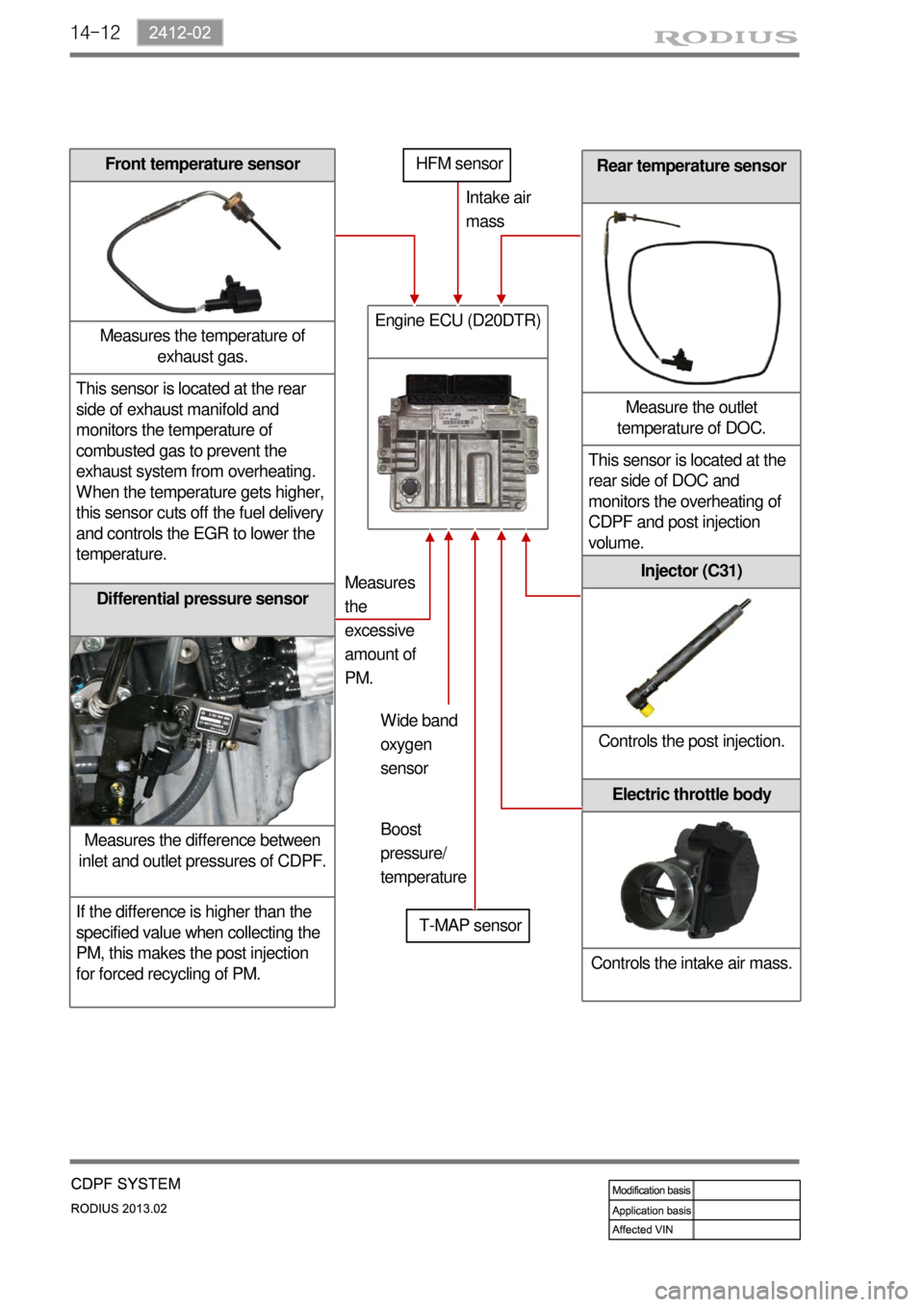Page 322 of 796
14-10
3. INPUT/OUTPUT DEVICES
Front temperature sensor: This sensor is installed at the inlet of DOC and detects whether the
DOC can burn (oxidize) the post-injected fuel or not.
Rear temperature sensor: This sensor is installed at the inlet of DPF and monitors that the
temperature of the exhaust gas is kept at 600℃. 1.
2.
If the temperature exceeds 600℃, the life of CDPF can be reduced. So the amount of fuel
post-injection is decreased.
If the temperature drops under 600℃, the rate of regeneration can be decreased. So the
amount of fuel post-injection is increased. -
-
Differential pressure sensor: This sensor checks the amount of PM collected by calculating the
pressure difference between before and after the CDPF.
Electric throttle valve: This valve reduces the intake air flow to raise the temperature of the exhaust
gas when the CDPF is operating during idling. 3.
4.
Page 323 of 796

14-112412-02
4. POST-INJECTION AND AIR MASS CONTROL
A DPS (Differential Pressure Sensor) measures the pressure difference between before and after the
CDPF and detects whether the soot is collected in the CDPF or not. If PM is collected in the CDPF (In
this case the pressure difference between before and after the CDPF exceeds the specified value.
Normally, the system sends the signal when the driving distance becomes approx. 600 to 1,200 km), the
temperature of exhaust gas is increased and the post-injection is started for regeneration. The amount
of fuel post-injection is controlled by the exhaust gas temperature measured by the rear temperature
sensor. If the temperature is less than 600℃, the amount of post-injection is increased to
increase the regeneration temperature. Otherwise, the fuel injection amount is decreased or the fuel is
not injected.
When the engine is running with low load, the intake air amount is also controlled as well as fuel injection
amount. This function is used to increaser the combustion temperature by increasing the amount of fuel
post-injection with the lowest air amount within the specified control logic.
Page 324 of 796

14-12
Rear temperature sensor
Measure the outlet
temperature of DOC.
This sensor is located at the
rear side of DOC and
monitors the overheating of
CDPF and post injection
volume.
Differential pressure sensor
Measures the difference between
inlet and outlet pressures of CDPF.
If the difference is higher than the
specified value when collecting the
PM, this makes the post injection
for forced recycling of PM.
Front temperature sensor
Measures the temperature of
exhaust gas.
This sensor is located at the rear
side of exhaust manifold and
monitors the temperature of
combusted gas to prevent the
exhaust system from overheating.
When the temperature gets higher,
this sensor cuts off the fuel delivery
and controls the EGR to lower the
temperature.
Engine ECU (D20DTR)
T-MAP sensorIntake air
mass
Measures
the
excessive
amount of
PM.
Injector (C31)
Controls the post injection.
Electric throttle body
Controls the intake air mass.
HFM sensor
Wide band
oxygen
sensor
Boost
pressure/
temperature
Page 325 of 796
14-132412-02
Collecting PM
→ Regeneration
The engine ECU detects the
amount of PM collected by the
information from the
temperature sensors and
differential pressure sensor.
When the soot is accumulated,
the engine ECU performs post-
injection to increase the
exhaust gas temperature and
burns the collected PM at
approx. 600°C.Oxidation (DOC)
When the exhaust gas enters
into the CDPF assembly, its
CO, HC and PM are reduced
by the redox reaction of the
DOC. The remaining PM is
filtered and collected in CDPF,
and the temperature of the
exhaust gas is increased to
between 450 and 500°C.
5. OPERATING PROCESS
[Configuration and principle of operation]
The exhaust gas
passed through the
exhaust manifold
enters into the CDPF
assembly (at approx
250℃).
Page 326 of 796
14-14
1) Oxidation of DOC
The DOC oxidizes HC and CO of the exhaust gas in the two-way catalytic converter at 180℃ or
more, and performs best at the temperature between 400 and 500℃. The front EGT sensor
detects whether the DOC can burn (oxidize) the post-injected fuel or not, and sends the signal to the
ECU to maintain the DOC operating temperature between 300 and 500℃. The DOC reduces
CO and HC of the exhaust gas by redox reaction and also reduces small amount of PM.
Oxygen adheres to the catalyst materials: Less than 180℃
1.
CO and HC are oxidized by the catalyst materials: More than 180℃ 2.
Page 328 of 796
14-16
3) PM Regeneration of DPF
The differential pressure sensor installed in the DPF measures the pressure values of inlet and outlet of
CDPF. And the amount of the PM collected in the filter is calculated based on the exhaust temperature,
intake air mass flow, booster pressure, etc.
The regeneration is started when the amount of the collected PM is 28 g or more.
The ECU commands post-injection to increase the temperature of CDPF to 600℃.
When the amount of the collected PM is not enough: The DPF works as a filter. 1.
When enough amount of PM is collected: The ECU commands post-injection and increase the
exhaust gas temperature to start regeneration. 2.
Page 331 of 796
15-30000-00
1. ENGINE DATA LIST
Data Unit Value
Coolant temperature℃ 130℃~-40℃
Intake air temperature℃ -40 to 130℃ (varies by ambient air
temperature or engine mode)
Idle speed rpm 750 ± 50 (P/N)
Engine load % 18~25%
Mass air flow kg/h 16 to 25 kg/h
Throttle position angle°TA 0° (Full Open) to 78° (Close)
Engine torque Nm varies by engine conditions
Injection time ms 3 to 5ms
Battery voltage V 13.5 V to 14.1 V
Accelerator pedal position 1 V 0.4. to 4.8V
Accelerator pedal position 2 V 0.2 to 2.4 V
Throttle position 1 V 0.3 to 4.6 V
Throttle position 2 V 0.3 to 4.6 V
Oxygen sensor V 0 to 5 V
A/C compressor switch
1=ON / 0=OFF -
Full load 1=ON / 0=OFF -
Gear selection (A/T) 1=ON / 0=OFF -
Knocking control 1=ON / 0=OFF -
Brake switch 1=ON / 0=OFF -
Cruise control 1=ON / 0=OFF -
Page 332 of 796
15-4
Oxygen Sensor
Glow Plug
1. MAJOR COMPONENTS
HFM
(Air mass/Temperature)
Injector (C3I)IMV
E-VGT Actuator